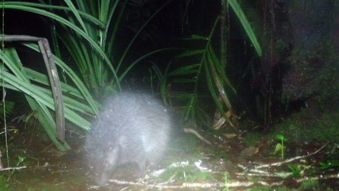Disappearing jewels: an urgent need for conservation of Fiji's partulid tree snail fauna
- Description:
- Where conservation status of island non-marine molluscs is known, snails tend to be one of the most threatened faunal groups. However, published information regarding island gastropod conservation status, diversity and endemism is frequently unavailable despite the importance of this information for the formulation of biodiversity action plans and conservation strategy. Fiji, for example, has a diverse native land snail fauna (.240 species) with an endemism level of ,80%, but only within the last few years has any information about any of these species been available to the national biodiversity reporting repository. For one lineage in particular, members of the tree snail family Partulidae, with four endemic Fiji Island species, the conservation status of the group has never been assessed. However, based on the alarming extinction rates documented in partulid snail species on other Pacific Islands, information about the occurrence and status of these taxa is urgently needed for Fijis biodiversity action plan. To redress this information void, we formulated the Fijian Partulid Tree Snail Project, consisting of five components: (1) raising awareness; (2) locating populations and monitoring population trends; (3) elucidating patterns of genetic diversity; (4) creating action partnerships; and (5) conducting disturbance gradient analyses. The overall goal was to characterise mechanisms leading to persistence of partulids in the face of increasing anthropogenic disturbance. In the initial stages of this project, existing information on Fijis partulids was collated and two small, remote islands in the Fiji archipelago were surveyed to investigate whether tree snails persisted there. Living populations of Partula lanceolata and empty shells of Partula leefei were found on Cicia Island in Lau, and on Rotuma Island in the Rotuma Group, respectively. DNA analyses confirm a sister relationship between the two Partula species in north-eastern Lau, P. lirata and P. lanceolata, with both sharing a sister relationship with a member of the same genus in Vanuatu P. auraniana Hartman, 1888. Prioritisation and further sampling of additional islands, and residual native habitat on less accessible islands and islets, is needed to fully assess the conservation status of all four Fijian species via the IUCN Red List process. Moreover, the basic descriptive information and associated studies reported here will serve to raise awareness of Fijis endemic tree snails particularly in communities that had no prior knowledge of their special conservation status; and also at a wider national, regional and global level. Community awareness is particularly vital as the willing support of land owners in the relevant small island communities is critical to implementing any future conservation action plans.
- Display date:
- 2017
- Collections:
- Secretariat of the Pacific Regional Environment Programme (SPREP)
- Publisher:
- CSIRO Publishing
- Content partner:
- Secretariat of the Pacific Regional Environment Programme (SPREP)
- Availability:
- Not specified
-
Copyright status: All rights reservedFind out more about what you are able to do with this itemThis item is all rights reserved, with means you'll have to get permission from Secretariat of the Pacific Regional Environment Programme (SPREP) before using it. For more information, please see our use and reuse page.What can I do with this item?Non-infringing useNZ copyright law does not prevent every use of a copyright work, and this item may be hosted by an international institute or organisation. You should consider what you can and cannot do with a copyright work.No sharingYou may not copy and/or share this item with others without further permission. This includes posting it on your blog, using it in a presentation, or any other public use.No modifyingYou are not allowed to adapt or remix this item into any other works.No commercial useYou may not use this item commercially.
Related items
Welcome and warm Pasifik greetings
The information on this site has been gathered from our content partners.
The names, terms, and labels that we present on the site may contain images or voices of deceased persons and may also reflect the bias, norms, and perspective of the period of time in which they were created. We accept that these may not be appropriate today.
If you have any concerns or questions about an item, please contact us.
